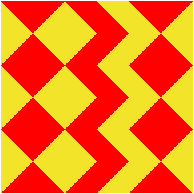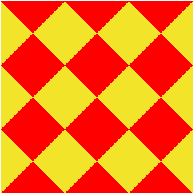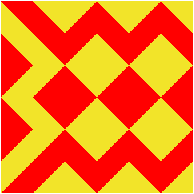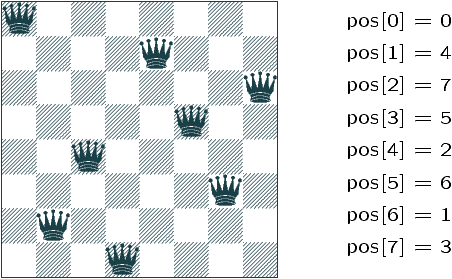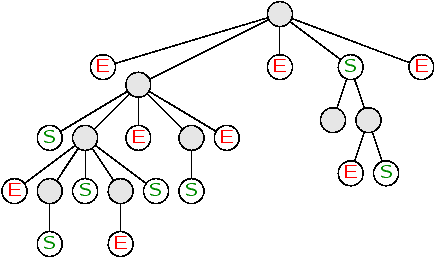Plan
.65@percent
-
Backtracking
- Algorithmes gloutons
- Programmation dynamique
- Enumération brutale
[D. Harel],
Algorithmics: The Spirit of Computing,
Addison-Wesley, 1st edition, 1987; 2nd edition, 1992;
3rd edition (with Y. Feldman), 2004.
Dominos de Wang (1/2)
 |
| p=4 |
|
|
|
|
|
Pavages de carrés n× n avec p dominos (carrés à bords colorés).
Dominos de Wang (2/2)
 |
| p=3 |
|
|
|
|
|
Wang ®
Berger ®
Penrose
Les 8 reines (1/3)
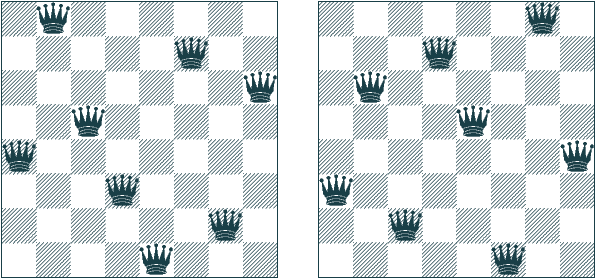
Mettre 8 reines sur un échiquier sans qu'elles ne soient
en prise.
Les 8 reines (2/3)
pos[i] = j si la reine de la ligne i est en colonne j.
Les 8 reines (3/3)
Reineseinesonflitompatible
static void nReines (int n) {
int[ ] pos = new int[n]; reines (pos, 0);
}
static void reines (int[ ] pos, int i) {
if (i >= pos.length) imprimerEchiquier(pos);
else
for (int j = 0; j < pos.length; ++j) // backtracking
if (compatible (pos, i, j)) {
pos[i] = j;
reines (pos, i+1);
} }
static boolean compatible (int[ ] pos, int i, int j) {
for (int k = 0; k < i; ++k)
if (conflit (i, j, k, pos[k])) return false;
return true;
}
static boolean conflit (int i1, int j1, int i2, int j2) {
return (i1 == i2) || (j1 == j2) ||
(Math.abs (i1 - i2) == Math.abs (j1 - j2));
}
Backtracking (1/2)
-
Plusieurs choix pour arriver à un noeud succès
(S). On peut aussi arriver sur un échec (E).
- Si on parvient à un échec, on fait un retour en arrière
(backtracking) pour tenter un autre choix.
- Il y a donc différentes stratégies pour arriver à un succès.
Þ Plusieurs solutions possibles (non-déterminisme).
Backtracking (2/2)
- Beaucoup de problèmes
n'ont pas de meilleure solution (pour l'instant).
- On cherche la solution avec plusieurs retours en arrière possibles.
- On s'arrête dès qu'on trouve une solution.
- Avec un oracle non déterministe, on trouve souvent la
solution en temps polynomial. Problèmes NP.
Exercice 1 Donner la complexité non déterministe des dominos de Wang.
Exercice 2 Donner la complexité non déterministe du problème des n
reines.
Problèmes NP
La plus grande conjecture de l'informatique = un des 7 problèmes
ouverts du millénaire en mathématiques
(selon le
Clay Institute):
| P |
=? |
NP |
| |
|
|
|
=? |
| non déterministe |
| polynomial |
|
[Cook, 1971]
Exemples de problèmes NP: satisfiabilité des
expressions booléennes, 3SAT (satisfiabilité des
expressions booléennes en forme normale conjonctive avec 3 variables),
isomorphisme de sous-graphes, couverture de graphes, circuits
hamiltoniens, voyageur de commerce,
sac à dos, etc. [Karp, 1972]
cf. le cours Conception et Analyse des algorithmes en Majeure 2.
3 stratégies d'exploration
-
algorithmes gloutons
une solution locale Þ une solution globale
complexité en O(n)
- programmation dynamique
tabulation des solutions partielles Þ une solution globale
complexité souvent en O(n3)
- énumération [force brute]
avec retours en arrière [backtracking]
et éventuelles optimisations [pruning]
complexité en O(2n)
Remarque: la force brute ``améliorée'' permet à
Deep Blue de battre Garry Kasparov !
avalierbCoupsDeIBREansEchiquier
Cavalier d'Euler (1/2)
Un cavalier doit parcourir toutes les cases d'un
échiquier sans passer deux fois par la même case.
Algorithme: aller vers la case où on peut le moins se
déplacer, le coup suivant.
final static int LIBRE = -1;
final static int[ ] x = {2, 1, -1, -2, -2, -1, 1, 2};
final static int[ ] y = {1, 2, 2, 1, -1, -2, -2, -1};
static void cavalier (int[ ][ ] m, int i, int j) {
int coup = 0; int i0, j0;
do {
m[i][j] = coup++;
i0 = i; j0 = j;
int min = Integer.MAX_VALUE;
for (int k = 0; k < x.length; ++k) {
int n = nbCoupsDe (m, i0+x[k], j0+y[k]);
if (min > n) {
i = i0+x[k]; j = j0+y[k];
min = n;
} }
} while (i != i0 || j != j0);
}
Cavalier d'Euler (2/2)
static int nbCoupsDe (int[ ][ ] m, int i, int j) {
if ( !dansEchiquier (m, i, j) || m[i][j] != LIBRE )
return Integer.MAX_VALUE;
else {
int res = 0;
for (int k = 0; k < x.length; ++k) {
int i1 = i+x[k], j1 = j+y[k];
if ( dansEchiquier (m, i1, j1) && m[i1][j1] == LIBRE )
++res;
}
return res;
} }
static boolean dansEchiquier(int[ ][ ] m, int i, int j) {
return 0 <= i && i < m.length && 0 <= j && j < m[0].length;
}
Exemple d'algorithme glouton.
Exercice 3 Montrer que cet algorithme marche pour toutes les cases de
départ sauf une.
Programmation dynamique (1/2)
- La programmation dynamique [Bellman 57] consiste à
tabuler des résultats intermédiaires pouvant intervenir
dans le résultat de l'optimisation à effectuer, afin d'éviter la
duplication de calculs (programmation dynamique, bang-bang
control, etc)
- Souvent les résultats intermédiaires consistent à calculer une
généralisation du résultat.
- Exemple (cf. cours 3) du plus court chemin entre tous
les sommets d'un graphe. [Floyd-Warshall]
Programmation dynamique (2/2)
La fonction de [Fibonacci]
if (n < 2) return n; else return fib (n-2) + fib (n-1);
}
se calcule plus rapidement en tabulant:
int[ ] tab = new int[n+1];
tab[0] = 0; tab[1] = 1;
for (int i = 2; i <= n; ++i)
tab[i] = tab[i-2] + tab[i-1];
return tab[n];
}
(On peut même ne garder que les deux dernières valeurs!)
C'est un bel exemple de programmation dynamique.
lusLongueSSCINORD_OUESTUESTORDongueurred
Plus longue sous-séquence commune (1/2)
Plus longue sous-séquence commune entre deux chaînes de
caractères u, v Î S* (e chaîne vide).
FIN |
ssc(u, e) |
|
= |
|
ssc(e, u) = e |
NORD_OUEST |
ssc(ua, va) |
|
= |
|
ssc(u,v)a |
|
ssc(ua, vb) |
|
= |
|
ì
í
î |
| ssc(ua, v) si || ssc(ua, v)|| ³
|| ssc(u, vb)|| |
| ssc(u, vb) sinon |
|
|
Commande Unix diff; séquençage de l'ADN
Plus longue sous-séquence commune (2/2)
final static int FIN = 0, NORD_OUEST = 1, OUEST = 2, NORD = 3;
static int[ ][ ] plusLongueSSC (String u, String v) {
int m = u.length(); int n = v.length();
int[ ][ ] longueur = new int[m][n], pred = new int[m][n];
for (int i = 0; i < m+1; ++i) {longueur[i][0] = 0; pred[i][0] = FIN; }
for (int j = 0; j < n+1; ++j) {longueur[0][j] = 0; pred[0][j] = FIN; }
for (int i = 1; i < m+1; ++i)
for (int j = 1; j < n+1; ++j)
if (u.charAt(i-1) == v.charAt(j-1)) {
longueur[i][j] = 1 + longueur[i-1][j-1]; pred[i][j] = NORD_OUEST;
} else if (longueur[i][j-1] >= longueur[i-1][j]) {
longueur[i][j] = longueur[i][j-1]; pred[i][j] = OUEST;
} else {
longueur[i][j] = longueur[i-1][j]; pred[i][j] = NORD;
}
return pred;
}
Enumération de chemins (1/2)
Enumérer les chemins élémentaires dans un graphe (jamais deux fois un même
sommet).
ousLesCheminsDeRISLANCOIRfsystemutrintln
final static int BLANC = 0, GRIS = 1, NOIR = 2;
static void tousLesChemins (Graphe g) {
int n = g.succ.length; int[ ] couleur = new int[n];
for (int x=0; x < n; ++x) couleur[x] = BLANC;
for (int x=0; x < n; ++x) tousLesCheminsDe (g, x, couleur, null);
}
static void tousLesCheminsDe (Graphe g, int x, int[ ] couleur, Liste c) {
couleur[x] = GRIS;
c = new Liste (x, c); System.out.println (c);
for (Liste ls = g.succ[x]; ls != null; ls = ls.suivant) {
int y = ls.val;
if (couleur[y] != GRIS)
tousLesCheminsDe (g, y, couleur, c);
}
couleur[x] = BLANC; // ¬ Le changement
}
Enumération de chemins (2/2)
ousLesCheminsDeoStringiste
class Liste {
int val; Liste suivant;
Liste (int v, Liste x) {val = v; suivant = x; }
public String toString() {
if (suivant == null) return "" + val;
else return "" + suivant + " " + val ;
}
}
On peut aussi écrire
public String toString() {
return (suivant == null ? "" : suivant + " ") + val ;
Affaire de goût!!
| Enumération des chemins simples |
| = |
légère modification sur dfs. |
Exercices
Exercice 4 Enumérer les chemins simples en largeur d'abord.
Exercice 5 Tester si un graphe contient un circuit hamiltonien.
(Circuit passant par tous les sommets sans passer 2 fois par le même).
Exercice 6 Même question dans un graphe non dirigé.
Exercice 7 Un tour de Euler dans un graphe dirigé consiste à passer par
tous les arcs d'un graphe en ne passant jamais deux fois par le même
arc. Ecrire un programme pour tester l'existence d'un tel tour.
Exercice 8 Même problème dans un graphe non dirigé.
Exercice 9 Complexité de SSC?
Exercice 10 Comment implémenter la commande diff du système Unix?
Exercice 11 L'associativité de la multiplication de matrices permet de
multiplier n matrices M0M1... Mn-1 sans préciser le
parenthésage. Pourtant, cela peut faire varier le nombre de
multiplications scalaires à effectuer. Donner un algorithme qui
utilise la programmation dynamique pour trouver l'ordre optimal.
This document was translated from LATEX by
HEVEA.

